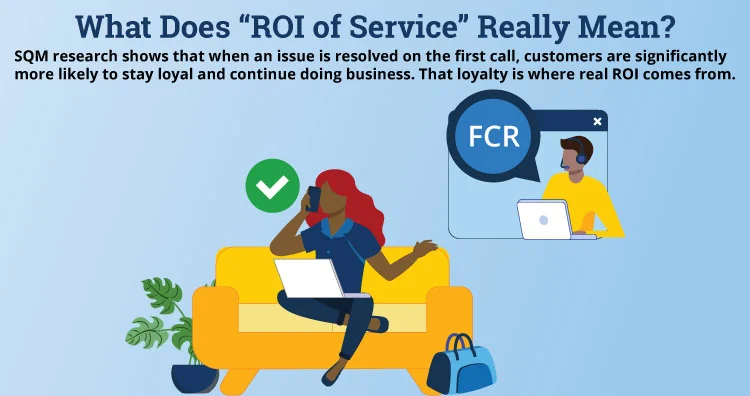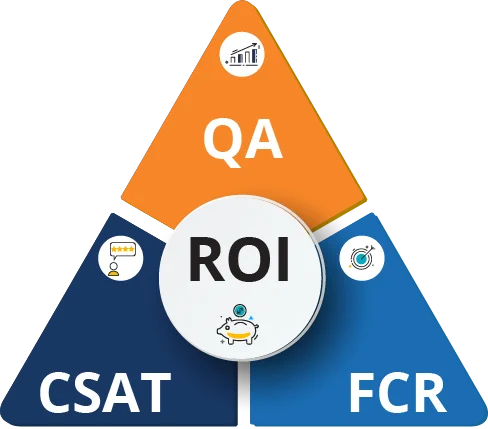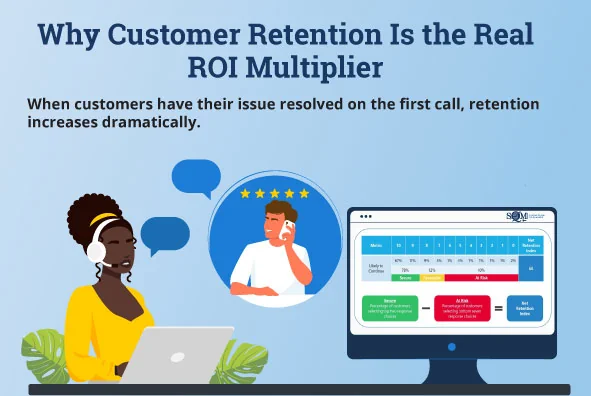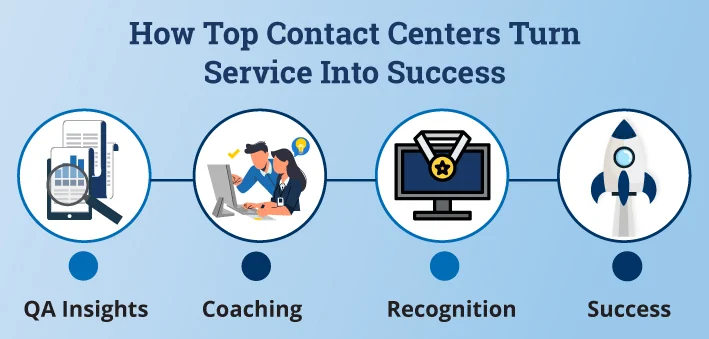Customer service isn’t just about fixing problems—it’s about creating value. Every conversation your agents have is a chance to build trust, strengthen loyalty, and influence whether a customer continues doing business with you. But many organizations still view their contact center as a cost, not a growth driver. In reality, strong service quality can deliver one of the highest returns on investment (ROI) across the entire business.
At SQM Group, we’ve seen that the real ROI of service comes from how well a contact center connects three key metrics: Quality Assurance (QA), Customer Satisfaction (CSAT), and First Call Resolution (FCR). When these three improve together, customers stay longer, costs go down, and revenue grows. For example, when a customer’s issue is resolved on the first call, they are far more likely to stay loyal, which has a direct impact on profitability.
In this blog, we’ll break down how better conversations lead to better conversions—and how focusing on service quality creates financial results you can see. We’ll show how QA, CSAT, and FCR tie directly to business outcomes, how feedback turns into growth, and how your contact center can shift from solving problems to driving ROI. Because when service quality improves, loyalty grows—and loyalty is one of the strongest ROI drivers an organization can have.
What Does “ROI of Service” Really Mean?
When most people hear “ROI,” they think of sales numbers, marketing results, or cost-cutting. But in a contact center, ROI comes from something more personal—how each customer conversation shapes the way someone feels about your brand. Those feelings drive real behavior: whether the customer stays, leaves, spends more, or recommends you to others.
A single strong interaction can turn a frustrated caller into someone who trusts your company again. A poor interaction can do the opposite and push them away.
SQM research shows that when an issue is resolved on the first call, customers are significantly more likely to stay loyal and continue doing business. That loyalty is where real ROI comes from.
So, the ROI of service isn’t only about reducing handle time or improving efficiency. It’s about creating experiences that build long-term value. When agents listen well, communicate clearly, and fully resolve the issue, customers reward the organization through repeat business and positive word of mouth—two of the strongest drivers of revenue growth.

How Do QA, CSAT, and FCR Work Together to Create ROI?
Service ROI doesn’t come from one metric—it comes from how multiple metrics work together. In most contact centers, QA, CSAT, and FCR are the core drivers of both customer experience and financial performance.
Here’s how each contributes:
- QA measures how well agents follow processes, communicate clearly, and meet the organization’s standards.
- CSAT tells you how the customer felt about the experience—did they feel heard, respected, and understood?
- FCR measures whether the customer’s issue was fully resolved during the first contact.
When these three are aligned, the contact center can clearly see what’s working and what’s getting in the way of customer satisfaction.
For example, if an agent receives high QA scores but customers report dissatisfaction, something deeper is happening—maybe the process is too rigid, or the agent is missing empathy cues. On the other hand, an agent with average QA performance but high CSAT may excel at making customers feel supported, showing an opportunity to improve the process or script.
SQM’s Customer Quality Assurance (CQA) approach helps organizations connect these dots by combining QA evaluations with post-call survey feedback. This shows leaders exactly where agent behavior matches customer expectations—and where improvements will have the biggest impact. When QA, CSAT, and FCR all improve together, every interaction delivers stronger ROI.

Why Customer Retention Is the Real ROI Multiplier
Winning a new customer can cost up to five times more than keeping an existing one. That’s why retention is one of the most powerful ROI drivers in a contact center. At SQM Group, we measure retention using the Net Retention Index (NRI), which indicates whether a customer plans to continue doing business after their interaction.
Across millions of surveys, one thing has remained consistent:
When customers have their issue resolved on the first call, retention increases dramatically.
A few simple examples:
- A customer who receives a quick answer about a refund is likely to trust the company more.
- A caller who is transferred multiple times for their problem may feel the company is disorganized.
- A customer who receives clear next steps becomes more confident in the brand.
Each of these experiences affects whether the customer stays or leaves—and staying is where ROI grows.
When FCR, CSAT, and QA improve, retention strengthens. And when retention strengthens, the organization loses fewer customers, spends less on acquisition, and increases long-term revenue. A loyal customer may purchase again, upgrade a service, or recommend the company—all actions that directly impact ROI.
In short, retention is where the financial payoff of great service truly multiplies.

How to Turn Quality Insights Into Business Growth
Every conversation creates a piece of information—what went well, what went wrong, and what could be improved. The challenge is turning that information into action.
Tools like mySQM™ Auto QA and customer feedback insights make this easier. They surface patterns that would otherwise go unnoticed, such as:
- multiple callers struggling with the same policy
- agents missing an important step in the process
- tone-of-voice cues linked to low satisfaction
- repeat issues that slow down resolution
For example, if mySQM™ Auto QA flags many customers calling back for the same product issue, leaders can quickly update training or create a clearer explanation for agents to use. This small change can cut repeat calls and improve both CSAT and FCR.
The value comes from doing something with the insights—not just reviewing them.
When supervisors coach agents using real examples, and when teams act on feedback, performance improves. Agents become more confident, customers feel more supported, and interactions become more efficient. Over time, these improvements lower operational costs and increase loyalty—creating a direct line from quality insights to business growth.

How Top Contact Centers Turn Service Into Success
The best contact centers share one important trait: they see every interaction as a chance to build trust, not just close a ticket. These organizations use QA results, customer feedback, and FCR data to guide improvement—not to check boxes.
Here are a few real-world examples:
- A team reviews common customer frustrations each week and updates scripts or knowledge articles based on what they learn.
- Supervisors coach agents using call recordings or survey comments instead of generic advice.
- Organizations celebrate wins—like improved FCR or great customer comments—through recognition programs linked to mySQM™ tools.
These simple habits turn service quality into something consistent and meaningful. Agents feel supported, customers feel valued, and leadership gains confidence that their contact center is improving in ways that impact the bottom line.
Top-performing centers don’t wait for problems to appear—they use insight to prevent them, improve them, and learn from them. When quality becomes part of everyday work, ROI becomes a natural outcome.

From Service Quality to Sustainable Growth
Long-term growth doesn’t come from transactions—it comes from relationships. Customers stay loyal when they feel heard, helped, and respected. When contact centers deliver that kind of service, the financial benefits follow.
Improving QA, CSAT, and FCR strengthens relationships, reduces repeat calls, and increases revenue. The ROI of service becomes clear: better conversations lead to better conversions.
When agents deliver great service, customers stay longer. And when customers stay longer, organizations grow.
